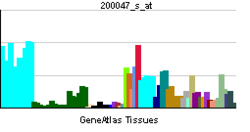- DAD1
-
Dolichyl-diphosphooligosaccharide--protein glycosyltransferase subunit DAD1 is an enzyme that in humans is encoded by the DAD1 gene.[1]
DAD1, the defender against apoptotic cell death, was initially identified as a negative regulator of programmed cell death in the temperature sensitive tsBN7 cell line. The DAD1 protein disappeared in temperature-sensitive cells following a shift to the nonpermissive temperature, suggesting that loss of the DAD1 protein triggered apoptosis. DAD1 is believed to be a tightly associated subunit of oligosaccharyltransferase both in the intact membrane and in the purified enzyme, thus reflecting the essential nature of N-linked glycosylation in eukaryotes.[1]
Interactions
DAD1 has been shown to interact with MCL1.[2]
References
- ^ a b "Entrez Gene: DAD1 defender against cell death 1". http://www.ncbi.nlm.nih.gov/sites/entrez?Db=gene&Cmd=ShowDetailView&TermToSearch=1603.
- ^ Makishima, T; Yoshimi M, Komiyama S, Hara N, Nishimoto T (Sep. 2000). "A subunit of the mammalian oligosaccharyltransferase, DAD1, interacts with Mcl-1, one of the bcl-2 protein family". J. Biochem. (JAPAN) 128 (3): 399–405. ISSN 0021-924X. PMID 10965038.
Further reading
- Yulug IG, See CG, Fisher EM, Ylug IG (1995). "The DAD1 protein, whose defect causes apoptotic cell death, maps to human chromosome 14.". Genomics 26 (2): 433–5. doi:10.1016/0888-7543(95)80241-D. PMID 7601483.
- Apte SS, Mattei MG, Seldin MF, Olsen BR (1995). "The highly conserved defender against the death 1 (DAD1) gene maps to human chromosome 14q11-q12 and mouse chromosome 14 and has plant and nematode homologs.". FEBS Lett. 363 (3): 304–6. doi:10.1016/0014-5793(95)00321-Y. PMID 7737422.
- Maruyama K, Sugano S (1994). "Oligo-capping: a simple method to replace the cap structure of eukaryotic mRNAs with oligoribonucleotides.". Gene 138 (1-2): 171–4. doi:10.1016/0378-1119(94)90802-8. PMID 8125298.
- Nakashima T, Sekiguchi T, Kuraoka A, et al. (1993). "Molecular cloning of a human cDNA encoding a novel protein, DAD1, whose defect causes apoptotic cell death in hamster BHK21 cells.". Mol. Cell. Biol. 13 (10): 6367–74. PMC 364695. PMID 8413235. http://www.pubmedcentral.nih.gov/articlerender.fcgi?tool=pmcentrez&artid=364695.
- Kelleher DJ, Gilmore R (1997). "DAD1, the defender against apoptotic cell death, is a subunit of the mammalian oligosaccharyltransferase.". Proc. Natl. Acad. Sci. U.S.A. 94 (10): 4994–9. doi:10.1073/pnas.94.10.4994. PMC 24619. PMID 9144178. http://www.pubmedcentral.nih.gov/articlerender.fcgi?tool=pmcentrez&artid=24619.
- Makishima T, Nakashima T, Nagata-Kuno K, et al. (1997). "The highly conserved DAD1 protein involved in apoptosis is required for N-linked glycosylation.". Genes Cells 2 (2): 129–41. doi:10.1046/j.1365-2443.1997.1070303.x. PMID 9167970.
- Suzuki Y, Yoshitomo-Nakagawa K, Maruyama K, et al. (1997). "Construction and characterization of a full length-enriched and a 5'-end-enriched cDNA library.". Gene 200 (1-2): 149–56. doi:10.1016/S0378-1119(97)00411-3. PMID 9373149.
- Zhong XP, Krangel MS (1999). "Enhancer-blocking activity within the DNase I hypersensitive site 2 to 6 region between the TCR alpha and Dad1 genes.". J. Immunol. 163 (1): 295–300. PMID 10384128.
- Makishima T, Yoshimi M, Komiyama S, et al. (2000). "A subunit of the mammalian oligosaccharyltransferase, DAD1, interacts with Mcl-1, one of the bcl-2 protein family.". J. Biochem. 128 (3): 399–405. PMID 10965038.
- Strausberg RL, Feingold EA, Grouse LH, et al. (2003). "Generation and initial analysis of more than 15,000 full-length human and mouse cDNA sequences.". Proc. Natl. Acad. Sci. U.S.A. 99 (26): 16899–903. doi:10.1073/pnas.242603899. PMC 139241. PMID 12477932. http://www.pubmedcentral.nih.gov/articlerender.fcgi?tool=pmcentrez&artid=139241.
- Gevaert K, Goethals M, Martens L, et al. (2004). "Exploring proteomes and analyzing protein processing by mass spectrometric identification of sorted N-terminal peptides.". Nat. Biotechnol. 21 (5): 566–9. doi:10.1038/nbt810. PMID 12665801.
- Gerhard DS, Wagner L, Feingold EA, et al. (2004). "The status, quality, and expansion of the NIH full-length cDNA project: the Mammalian Gene Collection (MGC).". Genome Res. 14 (10B): 2121–7. doi:10.1101/gr.2596504. PMC 528928. PMID 15489334. http://www.pubmedcentral.nih.gov/articlerender.fcgi?tool=pmcentrez&artid=528928.
- Shibatani T, David LL, McCormack AL, et al. (2005). "Proteomic analysis of mammalian oligosaccharyltransferase reveals multiple subcomplexes that contain Sec61, TRAP, and two potential new subunits.". Biochemistry 44 (16): 5982–92. doi:10.1021/bi047328f. PMID 15835887.
Categories:- Human proteins
- Chromosome 14 gene stubs
Wikimedia Foundation. 2010.

